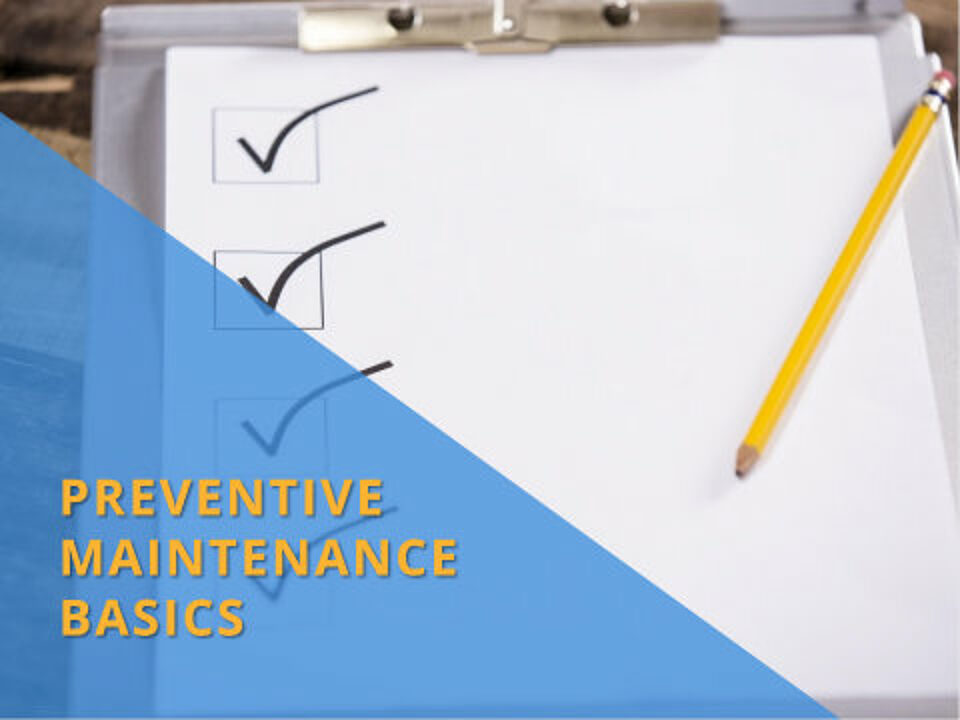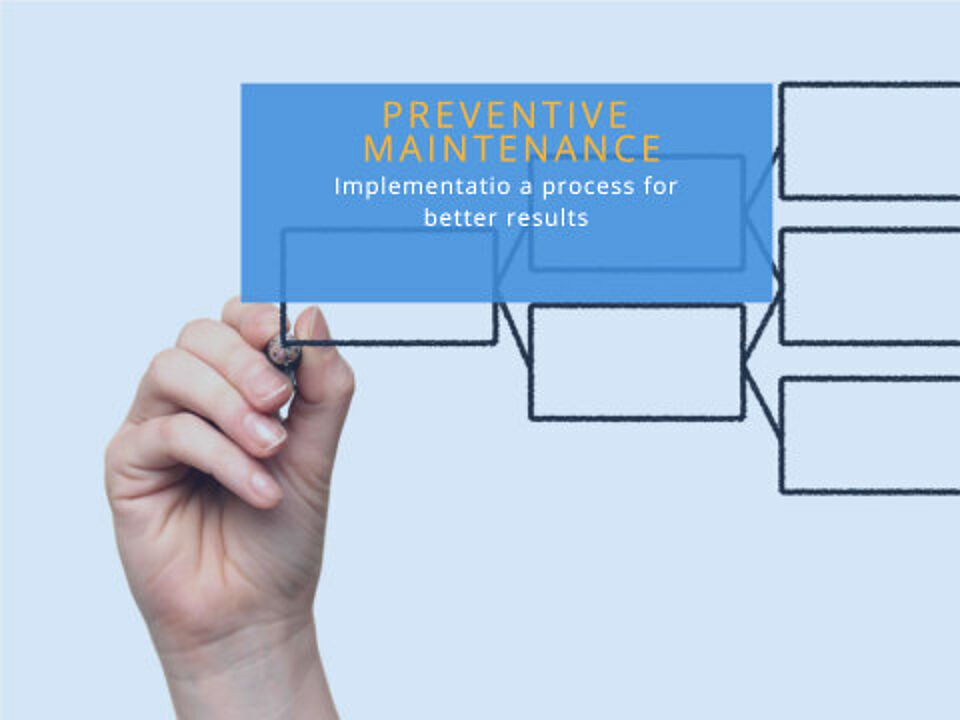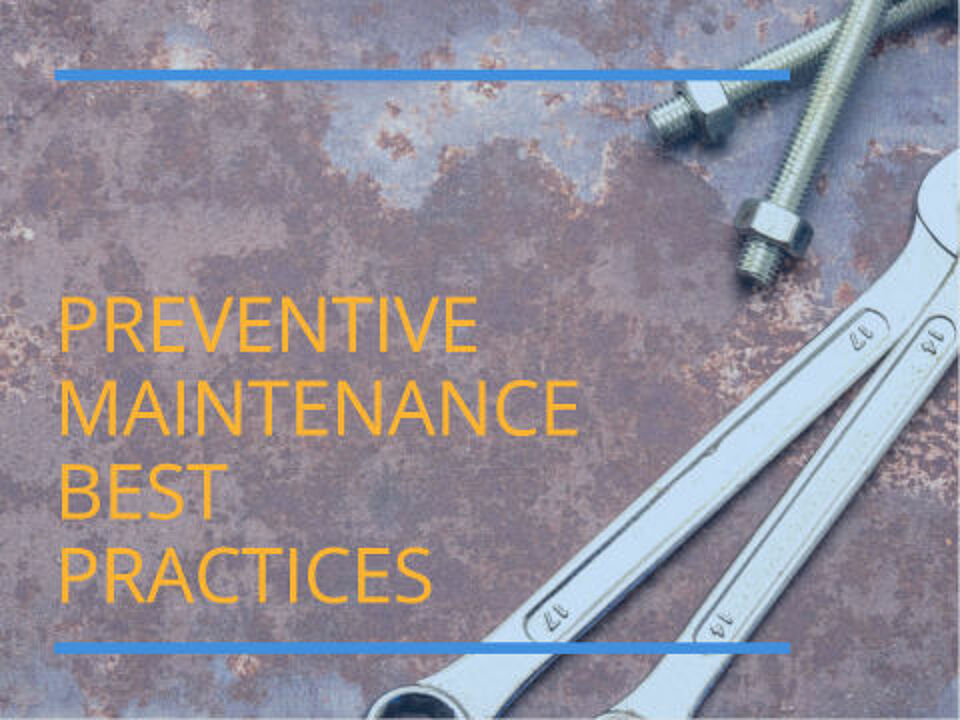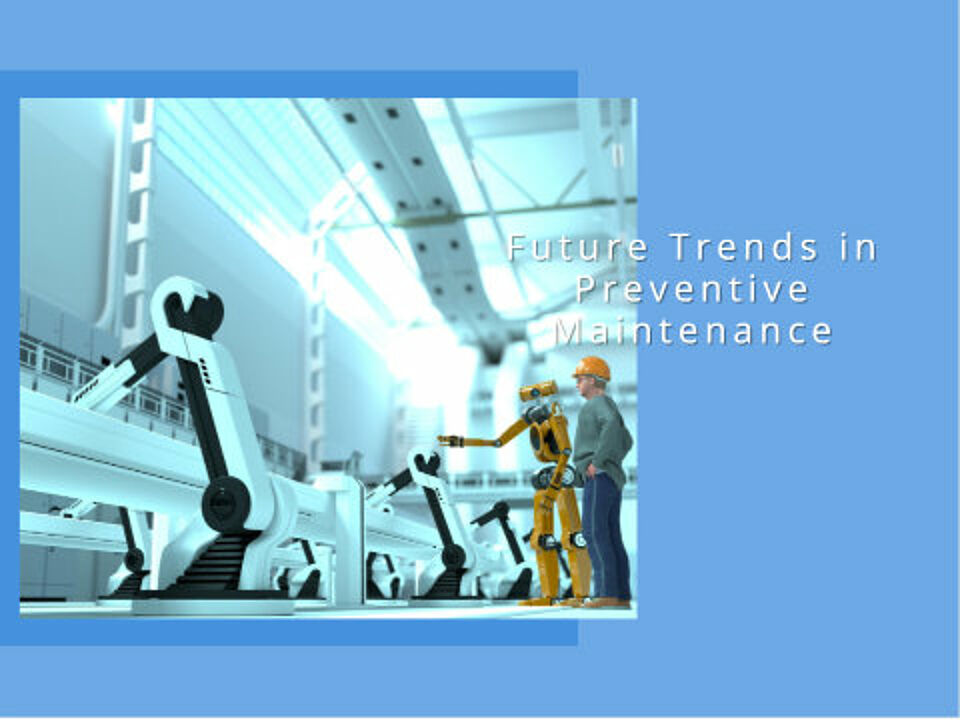
In a world where technology and machines play a central role in almost all aspects of daily life and business, maintaining their efficiency and reliability is of great importance. This is where the practice of preventive maintenance comes into play. This approach to servicing and maintaining plant and equipment is not only a method of avoiding unexpected breakdowns, but also an essential element in maximising the life and performance of valuable resources.
In this article, we will explore the basics of preventive maintenance, understand its importance and explain why it is essential in modern maintenance strategy.
Definition of preventive maintenance
Preventive maintenance refers to a proactive approach to maintenance in which regular and planned maintenance work is carried out on machines, equipment and systems. This is a prerequisite for ensuring optimum operating conditions and preventing potential failures before they even occur. In contrast to reactive maintenance strategies, which focus on repairing equipment after a breakdown, preventive maintenance aims to identify and fix problems before they can lead to serious malfunctions. This approach is based on a schedule or set performance indicators that determine when maintenance work is required and includes activities such as inspection, care, supply of auxiliary and operating materials and the replacement of wearing parts.
Brief overview of the importance of preventive maintenance
The importance of preventive maintenance cannot be overstated, especially in industries where plant and machinery play a critical role. By regularly carrying out preventive maintenance, companies can extend the life of their equipment, improve workplace safety and minimise costly downtime. This not only leads to greater operational efficiency and productivity, but also to significant cost savings by reducing the need for expensive emergency repairs and the associated loss of production. Furthermore, an effective preventive maintenance strategy helps organisations to ensure compliance with safety and quality standards and contributes to more sustainable operations.

The basics of preventive maintenance
Preventive maintenance is a strategic and organised method of looking after equipment that aims to maximise efficiency and minimise downtime. To fully understand its importance and effectiveness, it is important to understand the differences to reactive maintenance, identify the key components and know how it works in practice.
Difference between preventive maintenance and reactive maintenance
As briefly touched on above, the main difference between preventive and reactive maintenance lies in their approach to breakdowns and repairs. While reactive maintenance deals with fixing problems and repairing after a failure has occurred, preventive maintenance starts at a point before a failure can (preventively) happen. Reactive maintenance can often cause unexpected costs and downtime and leads to an increased risk of damage and safety issues. Preventive maintenance, on the other hand, schedules regular checks and maintenance to keep equipment in optimal condition and detect potential problems early.
Key components of preventive maintenance
There are several key components that are essential to an effective preventive maintenance programme:
- Maintenance planning: establishing regular intervals for inspections and maintenance tasks based on manufacturer recommendations or historical data.
- Task management: Defining specific maintenance tasks, coordinating and assigning them to qualified technicians.
- Spare parts management: Ensuring the availability of the necessary components and parts, spare parts and materials for planned maintenance work.
- Documentation and records: Detailed records of maintenance work performed and equipment condition reports.
- Employee training: Continuous training of employees to ensure that they have the necessary skills to carry out maintenance tasks effectively.
How preventive maintenance works
Preventive maintenance starts with careful planning and preparation. First of all, a maintenance plan is created based on the critical role of the equipment, operating hours and other relevant factors. Regular maintenance and inspection work is then scheduled, focussing on preventative measures such as cleaning, lubrication, replacement of defective components and performance checks. By using condition monitoring or predictive diagnostics tools, technicians can assess the condition of equipment and optimise maintenance work. This proactive approach enables potential sources of faults to be recognised and rectified at an early stage, resulting in increased plant safety, reliability and better cost control.
Advantages of preventive maintenance
Preventive maintenance is far more than just a maintenance routine; it is an investment in the future viability and profitability of a company. The benefits of a well-structured preventive maintenance programme are numerous and can have a significant impact on the overall success of an organisation.
Increasing plant reliability
A key aim of preventive maintenance is to increase the reliability of systems. Regular maintenance and inspections help to identify and eliminate potential causes of failure before they can lead to major problems. Reliable equipment is synonymous with consistent performance and quality, which in turn increases customer satisfaction and brand confidence.
Extending the service life of machines and systems
By implementing preventive maintenance strategies, machines and equipment are regularly serviced and maintained, resulting in less wear and tear. This significantly extends the life of equipment and delays the need for expensive new purchases. A longer service life also means that companies can maximise the value of their investment over a longer period of time.
Reducing unplanned downtime
Unplanned downtime can be costly for organisations, not only in terms of direct repair costs, but also in lost production and revenue. Preventive maintenance reduces the risk of unexpected downtime and ensures continuous operation. By minimising this downtime, companies can meet their production targets and avoid delivery delays affecting their customer relationships.
Cost savings by avoiding major repairs
By identifying and fixing small problems early, preventive maintenance prevents them from developing into larger, more costly problems. The cost of preventative measures is almost always lower than that of emergency repairs or complete equipment replacement. It also allows organisations to better plan and control their maintenance budgets, as preventative measures are predictable and predictable. This cost efficiency contributes to a company's financial stability and long-term success.

Implementation of preventive maintenance
The successful implementation of a preventive maintenance programme requires careful planning, the right choice of tools and technologies, and the commitment and training of staff. A well-designed programme can increase operational efficiency and ensure long-term benefits for the company.
Steps to implement a preventive maintenance programme
-
Inventory and evaluation
1
Analyse existing equipment and processes to understand current condition and maintenance needs.
-
Objective
2
Definition of clear objectives for the preventive maintenance programme, including desired results and key performance indicators (KPIs) for evaluating machine and process data.
-
Planning
3
Development of a comprehensive maintenance plan that includes schedules, responsibilities and specific maintenance processes. A high level of expertise is required here.
-
Resource allocation
4
Resource allocation: Ensuring that the necessary resources such as time, personnel and capital are available.
-
System integration
5
Establishment of a maintenance management system for monitoring maintenance work and recording data.
-
Continuous evaluation
6
Establishment of a process for regular review and adjustment of the programme to identify opportunities for improvement.
Selecting the right tools and technologies
Choosing the right tools and technologies is crucial to the efficiency and effectiveness of preventive maintenance. Modern maintenance software can assist in planning and monitoring maintenance work, while advanced diagnostic tools help to monitor the condition of equipment. Investing in IoT devices and sensors can enable predictive maintenance, where potential problems are detected before they lead to breakdowns.
Staff training and engagement
Staff engagement and competence are essential to the successful implementation and maintenance of a preventive maintenance programme. Employees must not only be trained in the use of new tools and technologies, but also understand the importance of preventive measures and their role in the process. A high level of commitment can be encouraged through regular training, clear communication of objectives and benefits, and recognition of good performance. A corporate culture that emphasises the importance of maintenance and reliability is equally important to ensure long-term employee support and commitment.
Condition Based Maintenance - CBM
Condition Based Maintenance is an advanced approach within preventive maintenance that focuses on making maintenance decisions based on the actual condition of the equipment. Unlike traditional preventive methods, which are based on a set schedule, CBM allows for more precise and efficient maintenance as actions are taken exactly when they are needed. This section looks at the different types of preventive maintenance with a particular focus on CBM.
Types of preventive maintenance
- Time-Based Maintenance (TBM):
TBM is the most traditional approach and is based on regular, scheduled intervals. Regardless of the actual condition of the equipment, maintenance work is carried out according to a predefined schedule. - Condition Based Maintenance (CBM):
CBM utilises real-time data and advanced monitoring technologies to monitor the physical condition of an asset. Maintenance decisions are made based on direct indicators, such as vibration, temperature or noise levels, which give an indication of the performance and condition of the equipment. - Predictive maintenance (PdM):
PdM goes one step further than CBM by using advanced analytics and machine learning to monitor the condition of equipment and predict when maintenance or repair will be needed. This method enables even more accurate planning of maintenance work. - Reliability-centred maintenance (RCM):
RCM is a comprehensive approach that aims to determine the optimal maintenance strategy for each asset based on its importance to operations and its risk of failure. RCM combines different maintenance strategies to maximise reliability and performance.
Importance of Condition Based Maintenance
CBM plays a central role in modern maintenance strategies as it enables companies to use their resources more efficiently and minimise downtime. By monitoring the actual condition of equipment, maintenance teams can act proactively before serious problems occur. This leads to improved equipment reliability, longer equipment lifecycles and lower overall operating costs. While implementing CBM requires an initial investment in monitoring technologies and data analytics capabilities, the long-term savings and efficiencies usually far justify these costs.

Best practices in preventive maintenance
To make a Preventive Maintenance programme successful, it is important to apply best practices that increase efficiency and ensure that maintenance activities create real value for the business before forced repairs occur.
These best practices include establishing regular reviews, effective use of data and continuous improvement of the programme.
Regular reviews and maintenance schedules
One of the pillars of an effective preventive maintenance programme is regular reviews and well thought out maintenance schedules. These include:
- Defined inspection intervals: it is crucial to set up a maintenance calendar based on the specific requirements of each machine.
- Detailed checklists: Detailed checklists should be available for each inspection and maintenance task to ensure that all relevant points are checked.
- Condition monitoring: The use of condition monitoring technologies helps to more accurately determine the need for maintenance work and only carry it out when it is actually required.
Utilisation of data and predictive maintenance
Data plays a crucial role in preventive maintenance. Advances in technology make it possible to collect and analyse large amounts of operational data to gain insights into the condition and performance of equipment. Predictive maintenance uses this data to predict maintenance needs and thus respond even more precisely to potential problems:
- Analysing operating data: By collecting and analysing operational data, patterns and trends can be identified that could indicate future failures.
- Predictive maintenance tools: These tools use algorithms and machine learning to predict failures and plan maintenance work before problems occur.
Continuous improvement and adaptation
Preventive maintenance is an ongoing process that requires constant review and adjustment to maximise its effectiveness. A continuous improvement programme includes
- Feedback mechanisms: setting up systems to collect feedback from technicians and operations staff who work with the equipment on a daily basis.
- Performance monitoring: Regularly assessing the performance of the maintenance programme against set KPIs and adjusting strategies based on this data.
- Training and development: Investing in ongoing training and professional development for maintenance staff to ensure they are familiar with the latest techniques and technologies.
These practices help ensure that a preventive maintenance programme not only runs smoothly, but also evolves with changes in technology and operating conditions.

Challenges in the implementation of preventive maintenance
Implementing an effective preventive maintenance programme can offer numerous benefits, but it is not without its challenges. Overcoming these obstacles is critical to the long-term success of the programme and ensuring business continuity.
Identifying priorities and critical assets
Prioritising maintenance activities is a complex task, especially in large organisations with many assets. The challenge lies in
- Criticality analysis: conducting a criticality analysis to determine which assets are most critical to operations and should therefore be prioritised.
- Risk management: Assessing the risk of failure and potential impact on production to ensure resources are allocated effectively.
- Alignment with operations: aligning maintenance schedules with operating hours to minimise disruption to production.
Budget constraints and resource allocation
Budget constraints can be a significant barrier to implementing a preventative maintenance programme. Companies must:
- Economic justification: It is often necessary to justify the cost-benefit aspects of preventive measures in order to secure the necessary budgets.
- Efficient use of resources: Resources need to be utilised efficiently to get the best result from any investment in preventive maintenance.
- Long-term planning: Budgets often need to be planned for the long term to ensure the continued funding of preventive maintenance activities.
Resistance to change within the organisation
Any change in operations can be met with resistance, and the implementation of preventive maintenance is no exception. To meet these challenges, organisations must:
- Support from the top: Managers need to support the programme and act as role models for adopting new processes.
- Communication and education: It is critical to communicate the reasons for change and get staff on board through education and training.
- Change management: Applying change management principles can help ease the transition to a preventative maintenance approach.
These challenges require targeted strategies and strong leadership to be successfully overcome. By tackling them head on, a company can lay the foundations for a robust and effective preventative maintenance programme.
Interface from EcholoN to SAP PM via EcholoN Data Workflow System - process optimisation
The integration and coupling of maintenance management systems such as EcholoN and SAP PM (Plant Maintenance) takes place via the EcholoN Data Workflow System and the SAP - Connector.
As an advanced workflow management solution, EcholoN offers companies the opportunity to optimise their maintenance processes and increase efficiency. By creating seamless interfaces between these systems, data and information can be exchanged in real time, resulting in improved coordination, planning and execution of maintenance work.
Benefits of integration
- Improved data consistency:
The direct connection between SAP PM and EcholoN ensures that all data, from asset information to maintenance histories, is kept consistent and up-to-date, reducing duplication of work and errors. - Automated workflows through EcholoN Workflow Engine:
By utilising the EcholoN Data Workflow system, automated workflows can also be deployed across systems based on specific events or data from SAP PM, for example. This enables a faster response time to maintenance requests and efficient resource allocation. - Improved decision-making:
Combining the powerful data analysis capabilities of EcholoN and SAP PM with the flexibility and customisability of EcholoN workflows enables managers to make more informed decisions and plan maintenance strategies with precision. - Centralised control and monitoring:
An integrated solution provides a centralised platform for monitoring and controlling all maintenance activities, resulting in improved visibility and control over the entire maintenance process.
Implementation of the interface
-
Needs analysis
1
First, a thorough analysis of the company's specific requirements is carried out in order to define the objectives of the integration and determine the scope.
-
System configuration
2
SAP PM and EcholoN are configured to enable seamless communication. This can include customising data fields, defining trigger events and setting up communication protocols.
-
Workflow design
3
Based on the requirements, specific workflows are designed in the EcholoN system that automate and optimise the maintenance processes across all systems.
-
Training and rollout
4
Employees are trained in the use of the integrated system to ensure smooth implementation and maximum acceptance.
-
Training and rollout
5
Employees are trained in the use of the integrated system to ensure smooth implementation and maximum acceptance.
The coupling of EcholoN and SAP PM via the EcholoN Data Workflow System offers a powerful solution for maximising the efficiency and effectiveness of maintenance processes. By automating workflows and improving data consistency, companies can optimise their maintenance strategies and ensure sustainable operations.

Future trends in preventive maintenance
The world of maintenance is constantly evolving, and with advances in technology come new opportunities to improve preventive maintenance strategies. Future trends in preventive maintenance show how companies can benefit from these technological developments and further optimise their maintenance practices.
Influence of IoT and Industry 4.0
The Internet of Things (IoT) and the concept of Industry 4.0 are revolutionising preventive maintenance. Smart sensors and connected devices enable seamless data collection and transmission in real time, leading to improved monitoring and analysis of operating conditions. This integration leads to:
- Enhanced condition monitoring: the ability to continuously monitor the condition of equipment and predict maintenance requirements more accurately.
- Automated maintenance procedures: Automation of maintenance tasks and use of robotics to increase efficiency and minimise human error.
- Integrated systems: Complete integration of production and maintenance data in a centralised system for better decision-making.
Artificial intelligence and machine learning in maintenance
Artificial intelligence (AI) and machine learning (ML) are becoming an integral part of advanced preventive maintenance strategies. These technologies offer:
- Predictive analytics: the ability to identify patterns in data that could indicate impending failures, thereby optimising maintenance planning.
- Intelligent diagnostics: AI-supported systems that are able to make complex diagnoses and provide recommendations for maintenance measures.
- Self-learning systems: Systems that learn from their own operating data and make adjustments on their own to optimise performance and reliability.
Sustainability and environmentally friendly practices
Sustainability is an increasingly important factor in all areas of business, including preventive maintenance. Future trends include:
- Resource efficiency: using preventive maintenance to reduce energy consumption and maximise the efficiency of machinery and equipment.
- Waste reduction: Reducing waste by extending the service life of equipment and recycling defective spare parts.
- Environmentally sustainable maintenance practices: using environmentally friendly materials and processes that not only protect the environment but also contribute to improving the public perception of the company.
These trends show that preventive maintenance is not only a question of operational efficiency, but is also closely linked to innovation and sustainability. Companies that embrace and integrate these trends are positioning themselves for long-term success and responsible growth.
Conclusion
Implementing a preventive maintenance programme can be a complex task, but the benefits it offers a company are undeniable and far-reaching. This conclusion summarises the key points and offers final thoughts on the importance of preventative maintenance.
Summarising the key points
- Preventive maintenance vs. reactive maintenance: Preventive maintenance is a strategic approach that aims to prevent problems before they occur, as opposed to reactive maintenance, which deals with problems after they have occurred.
- Advantages: The many benefits include increased equipment reliability, extended equipment life, reduced unplanned downtime and significant cost savings.
- Implementation: Successful implementation requires careful planning, selection of appropriate tools and technologies, and investment in employee education and engagement.
- Best Practices: Adherence to best practices such as regular reviews, use of data and continuous improvement is critical to the success of the programme.
- Future trends: With the emergence of new technologies such as IoT, AI and ML, as well as a growing focus on sustainability, preventive maintenance will continue to play an important role in the industry.
Final thoughts on the importance of preventive maintenance
Preventive maintenance is not only an operational necessity, but also a strategic decision that strengthens a company's resilience and efficiency in the long term. It is an essential part of modern operations management that not only increases productivity, but also contributes to safety, cost efficiency and sustainability. In a rapidly changing world where plant efficiency is a key competitive advantage, preventive maintenance is the key to staying ahead of these challenges. Companies that invest in a solid preventive maintenance programme are positioning themselves for success in today's fast-paced and technology-driven business world.
Frequently asked questions - Preventive Maintenance
FAQs
Preventive maintenance is a broad topic that raises questions for many business owners and plant managers. Below you will find answers to some of the most frequently asked questions that can help you better understand this important area.
What is the difference between preventive maintenance and predictive maintenance?
Preventive maintenance is based on regular and planned maintenance activities, regardless of the current condition of the equipment. Predictive maintenance, on the other hand, uses real-time data and advanced analysis techniques to predict the exact time for maintenance work based on the actual condition and performance of the equipment. While preventive maintenance follows a fixed schedule, predictive maintenance is data-driven and can potentially be more efficient as it recommends maintenance exactly when it is needed.
How often should preventive maintenance be carried out?
The frequency of preventive maintenance depends on several factors, including the type of equipment, operating conditions, manufacturer's recommendations and usage history. Typically, a maintenance plan is created that takes these factors into account and proposes a schedule for regular inspections and maintenance. Some systems require monthly maintenance, others quarterly or annually.
Can preventive maintenance be implemented in small companies?
Yes, preventive maintenance is beneficial for both small and large companies. Small businesses can reduce downtime and extend the life of their equipment through a customised preventive maintenance programme. It's about developing a maintenance plan that fits the size and capacity of the business and ensures that smaller businesses are utilising their resources efficiently.
How do you measure the success of a preventive maintenance programme?
The success of a preventive maintenance programme can be measured by various performance indicators, such as reducing downtime, extending equipment life, reducing maintenance costs and improving overall equipment effectiveness (OEE). An effective programme should lead to measurable improvement in these areas.
What role do employees play in implementing preventive maintenance?
Employees are a critical factor in implementing a successful preventive maintenance programme. Not only do they carry out the maintenance work, but they are often the first to recognise potential problems. Their involvement ranges from executing the maintenance plans to providing feedback for continuous improvement of the programme. Employee training and engagement is therefore key to ensuring that they understand the objectives of the programme and can effectively contribute to its success.
Maybe also interesting:
Maintenance software for reliable processes - EcholoN CMMS
Blog article: What is Predictive Maintenance?
Blog article: CMMS - Computerised Maintenance Management System
Blog article: Maintenance, inspection, repair and overhaul
Blog article: Maintenance and repair - relevant key performance indicators (KPIs) through CMMS software
Blog article: Computer Aided Facility Management - CAFM
Blog article: Internet of Things - IoT
